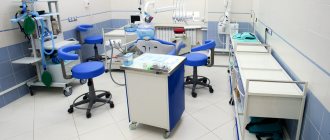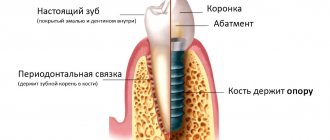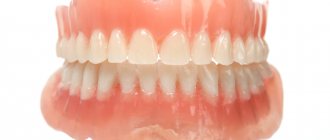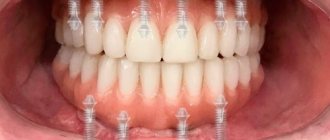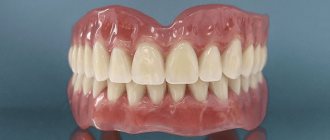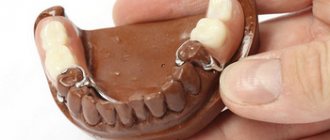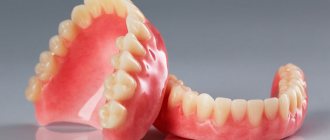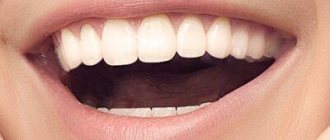Trauma, poor oral hygiene, dental diseases or their unfair treatment, as well as metabolic disorders and vitamin deficiencies can lead to tooth loss - adentia. In some cases, it may be a congenital pathology.
But do not despair, with the help of modern treatment methods, everyone can regain a beautiful smile and regain their former quality of life.
Complete dental prosthetics
In the classical sense, complete jaw prosthetics implies the presence of complete edentia, that is, when not a single tooth remains. Fixation of the prosthesis in the absence of teeth is carried out using implants or special suction cups located on the base of the removable denture.
Dental prosthetics in cases of complete absence of teeth are divided into three large categories.
- Removable dentures can be removed without assistance.
- Fixed - installed with support on dental implants.
- Conditionally removable - removed using professional tools by a dentist.
Prosthetics using removable and partially removable dentures
Complete removable dentures are used when all teeth are missing, and partial dentures are used when several are missing.
The finished orthopedic design should:
- It is firmly fixed in the oral cavity, performs a chewing function, and is aesthetic.
- Have no pores or roughness.
- Do not have a negative effect on the mucous membrane.
- Do not injure cheeks, tongue, lips.
It is important to note that all prostheses have a period of adaptation (getting used to) to it. The longest adaptation period is for acrylic ones (up to a month), the shortest for nylon and clasp ones (several days).
Prosthetics are always carried out over several visits and take several weeks. As a result, the patient receives not only a beautiful smile, but also fully restored chewing.
Types of complete dental prosthetics
Implantation today is an advanced method of restoring teeth, including those with complete edentia. Purely theoretically, it is possible to replace every lost tooth with implants, but such a procedure will cost enormous amounts of money, which in general is not entirely justified. Specifically for the diagnosis of complete edentia, clinicians have developed a number of concepts that allow the installation of a fixed prosthesis on a certain number of implants. Complete prosthetics of the upper jaw more often require osteoplastic surgery (compared to the lower jaw), since the bone here is less dense and voluminous.
Complete fixed dental prosthetics
All-on-4 (all on four)
Concepts of complete fixed dental prosthetics on 4 implants. The technique was developed by a well-known manufacturer of implantation systems - Nobel Biocare.
All-on-6 (all on six)
Method of complete fixed dental prosthetics using 6 implants. Considered a more reliable option than All-on-4.
Complete mandibular prosthesis Trefoil
The Trefoil concept is also from Nobel Biocare. The technique involves the use of only three implants and a special beam platform. However, the technology is used only when it is necessary to carry out complete prosthetics of the lower jaw. Due to anatomical features, upper dentures with complete absence of teeth must rest on at least four implants.
ReSmile
"ReSmile®" is a comprehensive solution for restoring chewing function in cases of complete absence of teeth and severe lack of bone tissue. The concept involves the restoration of all teeth with a complete fixed prosthesis on cement or screw fixation (14-16 teeth) with the rapid restoration of all functions of the jaw (chewing, swallowing and others), as it is carried out without incisions in the gums by puncture. Re-prosthetics are not required with this method.
ATTENTION!
As a temporary option for more reliable fixation of the prosthesis, mini-implants can be used. They are easy to install and do not require large amounts of bone.
Prosthetics with complete removable dentures
The option of fixed prosthetics is only possible with the installation of intraosseous dental implants. If this is not feasible, it makes sense to pay attention to removable prosthetics. These are products with a soft base and artificial teeth that copy the gums and the visible (crown) part of the teeth.
Acrylic
Prostheses made from special plastic. Suitable for complete prosthetics of the lower jaw and upper jaw due to good load distribution. Dentures are uncomfortable, promote the accumulation of bacteria, and the material itself can cause allergies.
Nylon
Good fixation, moisture resistance, hypoallergenicity and comfort are the qualities that make nylon prostheses worth paying attention to. On the other hand, they distribute pressure worse when chewing and sag over time (the bone tissue under such a prosthesis atrophies faster).
The best removable dentures for complete absence of teeth should be hypoallergenic, distribute the load well and not cause serious discomfort when worn.
Types of edentia
Adentia is the absence of teeth in the oral cavity. There are several types:
- Primary: when the patient initially did not have a permanent or baby tooth germ.
- Secondary: the tooth erupted, but after some time was removed (due to injury or caries and its complications).
Also distinguished:
- complete edentia: all teeth in the mouth are missing;
- partial (incomplete): one or more were removed.
Treatment and dental prosthetics are carried out only after diagnosis. It is important for the doctor to assess the condition of the gums and bone tissue. The treatment and prosthetic plan will depend on this.
The best dentures for complete absence of teeth
Many patients ask the question, which dentures are better for complete absence of teeth? On the one hand, the answer here is obvious. The best dentures for complete absence of teeth are placed on implants. It is titanium roots that prevent bone tissue loss, provide the necessary stability of the structure, distribute the chewing load as efficiently as possible and allow you to achieve good aesthetics. However, implantation cannot be performed in all cases, since the procedure has a list of contraindications and is not cheap. The cost of complete dental prosthetics can cost more than half a million rubles, and this is far from the limit. The Trefoil concept will be cheaper, but it has a significant limitation (it is impossible to carry out complete prosthetics of the upper jaw teeth).
Prosthetics on all-on-4 implants
The all-on-4 prosthetic technology was developed by the famous dental brand Nobel about 20 years ago and has become one of the optimal options for dental restoration for people facing the problem of complete edentia.
The key feature of all-on-4 is that to carry out prosthetics and secure a fixed prosthesis, only four dental implants need to be implanted. Due to the number of implants used in the operation, the technology got its name - “all on four”. The use of a small number of implants reduces the trauma of the surgical intervention stage and allows for dental restoration in the shortest possible time. The stability of the position of the prosthesis in the oral cavity is ensured by the special arrangement of the implants: during all-on-4, artificial roots are implanted according to a scheme specially developed for this protocol.
The implantation scheme ensures their reliable primary stability and makes it possible to immediately load the implants with a prosthesis. A temporary acrylic prosthesis is attached to the installed implants within a few hours after the main operation. Immediate installation of a prosthesis helps relieve the patient from psychological and physical discomfort: you will be able to smile without embarrassment and eat almost any food. Loading with a prosthesis also has a positive effect on the rate of implant healing.
TAKE NOTE: A removable denture on implants is placed temporarily - until the healing process of the implants is completed. When the implanted implants fuse with the jaw bone, the temporary plastic prosthesis is replaced with a permanent structure, which can be made from any material - ceramics, zirconium.
Who can be recommended for all-on-four prosthetics?
This denture option is suitable for people who have lost all their teeth in a row. The “all-on-four” prosthetic technique is also used when the remaining teeth in the mouth have to be removed: for example, if they are severely damaged and it is impossible to treat them and restore them with fillings.
When is it impossible to restore teeth with all-on-4 prosthetics?
Implantation using any of the technologies is a serious surgical intervention, therefore, naturally, there will be contraindications to it.
All-on-4 prosthetics are not performed if the patient has autoimmune diseases, pathologies that cause bleeding disorders, or some types of chronic general diseases of the body. You should be advised in detail about contraindications to all-on-4 prosthetics by an implantologist during your initial consultation before treatment. Moreover, the implantologist’s task will be to completely eliminate all possible contraindications, and this requires the most detailed diagnostics. TAKE NOTE: Some people think that diagnosis is the simplest and most insignificant event when preparing for implant prosthetics. But this is a dangerous misconception, because the results of treatment will depend on the quality of diagnosis before implantation and prosthetics! Based on diagnostic data, contraindications are excluded, treatment is planned, implants and areas for their implantation are selected, and prosthetic material is selected. Therefore, it is so important that the clinic where you go for dental treatment has modern diagnostic equipment and experienced, responsible doctors who understand the importance of high-quality diagnostics!
One of the contraindications to all-on-four prosthetics is severe atrophy of the jaw bone tissue. If a clear bone deficiency is diagnosed in the upper jaw, then the problem can be solved by installing special zygomatic implants, but atrophy of the lower jaw bone will require preliminary osteoplasty.
How will the prosthetics work?
Treatment will begin with a visit to the clinic and a series of diagnostic tests.
If diagnostics do not reveal contraindications to this prosthetic technology, then a detailed operation plan is developed, implants are selected, and the exact locations for their installation are determined. TAKE NOTE: When the all-on-4 prosthetic technology first appeared, it used exclusively Nobel brand implants. Over time, implantation systems that can be used for all-on-four implantation have appeared in the lines of other brands.
Kinds
Completely removable dentures are preferably placed if absolute adentia is diagnosed in the dentition or contraindications are identified during diagnosis that do not allow the installation of fixed dentures (crowns, bridges). Removable structures are attached either to the gum (lower jaw) or to the gum + palate (edentulous upper jaw). There is another way of fixation: on implants.
They are classified according to the principle of fastening:
- partial removable dentures (fixed in the oral cavity with the help of hooks that cling to the “native” teeth or implants. Nylon and plastic are used to make the prosthesis, sometimes a metal base is added. Such dentures are called clasp dentures);
- complete (installed when there is a complete absence of teeth in a row. The design is not reliable in terms of fastening, since there is no base for fixation. It is made of plastic. Removable dentures also include conditionally removable ones - they are attached to small implants implanted in the jaw).
In addition to the materials already mentioned, removable dentures are made of acrylic - a fairly reliable material, which, when installed correctly, looks quite aesthetically pleasing, and if the parameters are correctly selected, the design does not cause severe discomfort during adaptation.
For fastening the prosthesis, beam fasteners are often chosen. The beam is designed to carry a vertical load. The issue of load distribution is especially acute if “natural” teeth or implants are chosen for support. This fixation is reliable due to special recesses in the beam and locks in the structure. This device is used for complete and partial edentia.
Contraindications
Despite the fact that a person with a toothless mouth feels inferior and wants to get rid of the defect, it is not always possible to restore the dentition. Absolute contraindications to prosthetics are:
- allergy to material components;
- oncology;
- poor blood clotting;
- excessively low weight;
- severe diabetes mellitus;
- intolerance to anesthesia.
Relative contraindications include exacerbation of mental illness and viral infection. As soon as the patient recovers, full prosthetics begin.
Prosthetics on implants
If the patient’s budget and health condition allow for minimally invasive surgery, it is better to opt for implant prosthetics.
There is no need to install 28 units of titanium rods separately. In some cases, patients are offered the installation of 4-6 implants on each row and fixation of solid prostheses on them. Advantages of installing dentures on implants
- Reliability – the prosthesis on the implant is held as firmly as your own living tooth with roots.
- Aesthetics – dentition restored in this way pleases with its natural appearance and beauty.
- Ease of chewing
- Durability – the guarantee for implants is determined by the manufacturer at the level of 10-50 years. It is enough to choose the right prosthesis and forget about problems with missing teeth for several decades.
- Possibility of replacing dentures - if the coronal part is destroyed, you can always install a new denture on the metal root.
The disadvantages of the method include the presence of contraindications and higher cost compared to prosthetics without implants.
Soft and Flexible Nylon Dentures Pros and Cons:
Nylon dentures
Nylon dentures restore missing teeth when bridges or implants are not possible.
Although these prosthetic options are more optimal and easier to use. Prosthetics with nylon dentures is now one of the options for restoring a large number of teeth, a good alternative to conventional removable dentures. But not in all cases:
Differences between nylon dentures and other removable structures: they are made of nylon, which has elastic properties. Therefore, nylon prostheses are also called flexible or soft. They can bend without breaking, returning to their previous shape after being placed on the teeth.
Soft dentures made of nylon are very durable - they can bend strongly without breaking. It is almost impossible to break them. Unless you apply exorbitant loads, vandalism and playful hands to them.
Let us immediately warn you that the flexibility of removable nylon structures is not rubber-like. Otherwise, while chewing, he will not be able to chew food, he will bend and try to escape his direct responsibilities for grinding food.
Initially, flexible nylon prostheses were invented as temporary structures. To restore missing teeth for several months. Later, the indications for their use were expanded. Because they can solve problems that traditional removable structures cannot handle.
We have been using nylon dentures in dentistry since 2003. We have developed many nuances regarding their use, service life, effect on the gums and teeth, etc.:
Fixation of removable nylon dentures
Soft dentures are fixed to the teeth using nylon clasps.
There is no metal at all. Because of this, their aesthetics are very high. When putting on a nylon prosthesis, its clasps are bent and take their original shape at the moment of complete dressing:
Removal occurs the same way. A spontaneous fall will not happen, since sufficient effort must be made for this to happen.
Flexible dentures hold onto the remaining teeth without any metal clasps, locks or attachments. In case of complete absence of teeth, the retention of a flexible prosthesis occurs due to suction to the gum.
Advantages of nylon dentures
Soft nylon teeth have great advantages over traditional plastic teeth.
They also have disadvantages. First, about the positive aspects. Aesthetics Flexible dental prostheses provide fixation without causing aesthetic damage from metal. This quality of nylon teeth is especially convenient when holding on the front teeth - where metal is not at all appropriate.
Nylon is similar to gum and is translucent, the native gum is visible through it, so nylon dental prostheses look very natural:
Durability Nylon dentures are very durable and almost impossible to break. When pressure is applied to it, it bends, which allows it to cope with heavy loads without any breakage.
Due to flexibility, adaptation and adaptation to soft removable dentures occurs faster. Flexibility ensures strength under heavy loads - if accidentally dropped, they do not break, unlike traditional ones, but continue to work.
When putting on a soft removable denture, nylon clasps bend and tightly hug the supporting teeth, holding it firmly and preventing it from moving.
Weight Soft dentures weigh less than traditional ones made of plastic. The difference is small, but it is there.
Open palate Nylon dentures make it possible not to cover the palate when replacing the upper jaw, since the main retention occurs on the remaining teeth:
The left and right sides are not connected. On the lower jaw, in the absence of teeth on the left and right sides, a conventional removable structure is only possible for the entire lower jaw. In this case, both sides will be connected to each other by a strip of plastic behind the front teeth. This significantly increases the volume, creates discomfort, increases the period of adaptation and impairs use.
Nylon will allow you to make two separate structures. Not related to each other in any way. Saving their owner from many inconveniences.
Hypoallergenic Does not contain allergens. Conventional acrylic dentures can cause allergic reactions.
No need to treat teeth The 99.9% flexibility of a nylon denture allows you to do without treating the supporting teeth. Even if they are not very parallel.
Disadvantages of nylon prostheses
Now about the cons.
Like everything in the world, the positive aspects often turn out to be a place that is turned to the forest in Russian fairy tales. The same is true with flexible dentures. The unique properties of nylon allow it to be used where other options cannot cope. But these same properties also lead to the disadvantages of nylon prostheses: non-repairability. The main disadvantages of nylon prostheses are that nylon does not allow adding additional layers of any material to correct or change it. That is, once a flexible prosthesis has been made, it cannot be changed. When might the need for correction arise?
Soft dentures practically do not break, but if this happens after some extreme and barbaric impact, then it is impossible to repair it. We have to redo it again.
The same applies to the situation when the gums change their configuration (atrophy) after a few years. You can simply add an additional layer to regular plastic. So that it rests on the entire gum, and not just on part of it. This trick will not work with nylon prostheses.
Over time, any removable structure gradually deteriorates in fixation. Nylon is very abrasion resistant. But erasure is still possible over time. Then, due to periodic removal and putting on, fixation may deteriorate. Adding an additional layer of nylon will not work. Just a total remake. Or the use of special adhesives or gels.
If some tooth is removed after a few years. A regular denture will allow you to add an artificial tooth and you can continue to use it. You won’t be able to do this with nylon - you’ll have to do it all over again.
certain conditions for fixation There are situations when the use of nylon prostheses is difficult:
Nylon teeth are made without traditional metal clasps. This makes them very aesthetic, but the inability to add metal to nylon teeth creates certain difficulties in difficult situations when the nylon clasp may not be able to reliably hold the prosthesis. Metal could, but it can't be added to nylon teeth. Because nylon does not allow connection with metal or anything else.
They transfer the load on the teeth only horizontally, and cannot transfer the vertical load as in clasp teeth. More precisely, this can be realized, but due to its elastic properties, a soft nylon clasp prosthesis will not work normally. A flexible clasp is elastic and will bend.
aesthetic nuances Artificial teeth for any
removable structures are made of plastic. And nylon does not connect to plastic in any way. Therefore, artificial teeth are held in it only mechanically. In dentures with conventional plastic, the teeth are chemically connected, which allows the transition of the artificial gum to the tooth to be made more delicately.
The disadvantage of nylon dentures when fixed to the front tooth is that nylon is not completely transparent. With low teeth, this will lead to a visual shortening of the tooth on which it rests. Especially if it's short.
gum atrophy Flexible dentures can cause increased atrophy of the gums, bone tissue and supporting teeth. This is possible due to their elasticity.
Conventional removable designs rely on more chewing volume. Nylon ones bend and load smaller areas of the gums. Therefore, their atrophy may occur earlier.
When a flexible prosthesis has support in the form of its own teeth on both sides, there will be no increased atrophy. If the support is only on one side, it will go faster.
difficulty in polishing Nylon does not polish well. This nuance of working with it is taken into account by technicians during its manufacture. The finished nylon prosthesis will be polished perfectly. But if correction is required, then it is almost impossible for the doctor to polish these areas perfectly without the participation of a dental technician and his equipment by the dentist himself.
True, if performed correctly, corrections are minimal. It is a fact. May other dentists forgive me.
To speed up habituation, improve diction and ease of use in the upper jaw, we often recreate the palatal arches on the prosthesis. They make it very thin (1.5 mm) and more comfortable for the patient. Unfortunately, this cannot be done on flexible dentures due to the poor polishability of the material.
Examples of work “Before” and “After”
Basal implantation of both jaws with complete edentia
Case: the patient complained of missing teeth in the upper jaw, in the area of chewing teeth in the lower jaw, as well as mobility and pain when chewing in the area of the front teeth in the lower jaw.
Basal implantation of ROOTT with complete edentia
Case: destruction and absence of chewing teeth, destruction of frontal teeth under crowns, atrophy of bone tissue and gums due to periodontitis.
Expert opinion
Roman Borisovich Alekperov
orthopedic dentist
Experience: 24 years
Don't settle for removable dentures when modern dental technology offers more convenient and effective options. All-on-4 implantation will allow you to fix a complete denture on just 4 implants. And the unique basal method ensures the restoration of the entire dentition even with severe bone atrophy without first increasing its volume. In this case, prosthetics are performed the very next day after the implantation of basal implants.
Advantages of nylon prostheses
- Soft and pliable material, adheres to the jaw,
- The prosthesis does not rub;
- The product does not require long-term habituation;
- The prosthesis can be made in the shortest possible time;
- A high-quality nylon denture is invisible in the mouth and adequately performs the chewing function;
- There are no metallic inclusions, which means it is suitable for patients with allergies to metals;
- To secure the product in the oral cavity, a special adhesive composition or design can be used
- Fixed by suction to the mucosa.
What complications can there be?
The complete absence of teeth inevitably causes psychological problems, functional discomfort and quite dangerous consequences for the entire body:
- problems associated with eating: the inability to bite and chew food normally leads to serious diseases of the digestive tract,
- gingival subsidence and bone tissue atrophy, which causes difficulties in prosthetics,
- deformation of the shape of the face, the appearance of wrinkles, reduction of the lower third of the face, retraction of the lips into the oral cavity. If all teeth are missing, a person looks much older than his age.
How does the prosthetics process work?
The entire procedure consists of the following steps:
- Examination by a dentist, development of a treatment strategy.
- Taking an impression using dental instruments and special material.
- Checking the relationship of the jaws, the comfort of using dentures depends on this.
- Taking functional tests to form an impression. Based on the result, a wax frame is produced, which the patient can check.
- Installation and correction of the prosthesis after several days of use.
